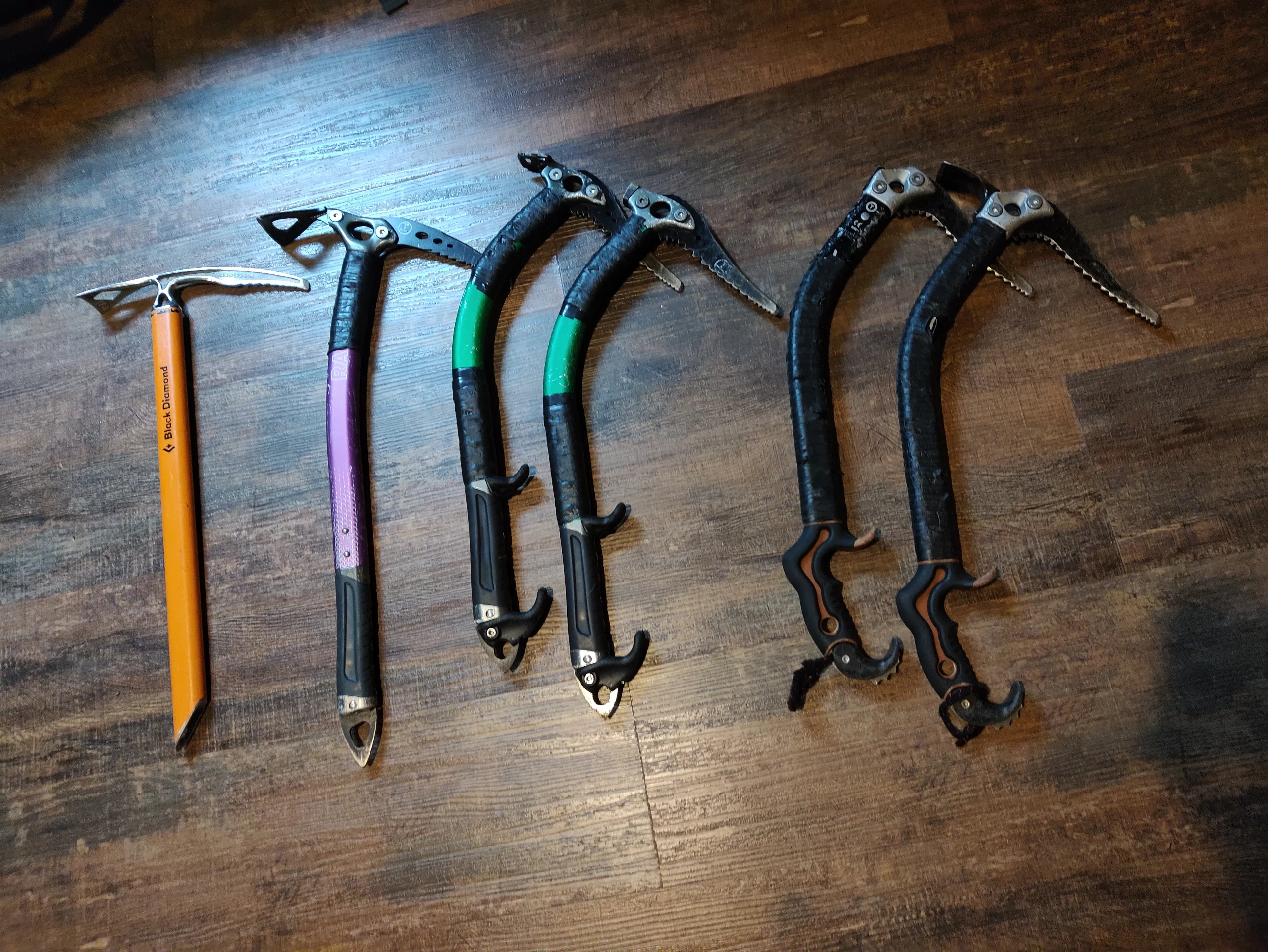
A Range of Ice Axes, (left to Right; light weight tool, mountaineering axe, all round tools, ice specific tools)

A Range of Ice Axes, (left to Right; light weight tool, mountaineering axe, all round tools, ice specific tools)
Ice axes are one of our favourite items of climbing equipment. They are incredibly versatile and allow you to perform an array of mountaineering techniques. However, there is a baffling range of ice axes available to buy, so which axe is best for which job? Read our five minute guide below:
The axe has two main parts; the shaft and the pick. Each of these is given a rating when manufactured. The B rating is given to ice axes designed to perform Basic functions. The T rating is given to Technical axes designed for climbing and mountaineering use. If in doubt I would recommend looking for an ice axe with both a T rated shaft and pick.
There’s a large variety of axes out there however most ice axes fall into one of the following categories:
Mountaineering Ice Axes – The shaft of mountaineering ice axes can either be straight or have a slight curve. A slight curve is often preferable since it helps to prevent you from bashing your knuckles when swinging the axe. They work well for mixed routes up to grade III and possibly some grade IV. Mountaineering axes are normally used as a single tool (which means they are not used as part of a pair with another ice axe or hammer). The shape of the shaft makes them easier to stow on your rucksack shoulder. They can plunge effectively for security on steeper snow slopes and they cut steps and ice more effectively than other axes. They are generally good for all round mountaineering. Look for a T rating and a weight typically 350g-800g This is probably my most commonly used axe for everything from Scottish hill walking, mountaineering and easy climbs, to big alpine peaks.
All Round Ice Axes – Great for ice climbing up to grade V or even perhaps grade VI or mixed routes of a similar standard. These have some curve on the shaft and a grip rest for the little finger. They are normally used as a pair with one adze and one hammer. The straighter the shaft the better the security on steep snow. The more bent the shaft the better at tackling steeper ice or mixed climbing. There’s a massive variety of tools that will fall into this category and they’re great for doing almost anything from easy climbs to pure ice. With many things there will be trade offs between different models but getting a set of all round axes is worth having. Look for a T rating and remember lightest is not always best. I have spent years climbing up to grade VI with this type of axe.
Ice Climbing Axes – These have a curved shaft and handle with ergonomic grip. They can have pick weights added for extra heft if swinging into ice. The handle will prevent plunging on steep snow so can feel insecure on more mountaineering routes of grade II or III. The handle also prevents you using these axes for some snow belay techniques, for example a stomper. This is traded off against giving much more precision on steep ice or mixed routes and more comfort for the hand so you don’t over grip as much. This is the tool to get for an ice climbing trip to Canada or Norway. They put a smile on your face with every swing but are less useful in a mountaineering context.
Light Weight Skiing Axe – This is an axe designed to be carried for emergency use rather than used all the time. Like many emergency items it has a place but if used day to day it’s not effective. When dealing with hard ice these tools often bounce and require a lot of force. Often these will be B rated and weigh less than 350g. I use one when I’m rock climbing or skiing in the alps and in need of something as a backup when I’m not expecting to really use it.
The best way to decide is to ask yourself a few questions; Can I afford multiple specialist axes or do I need something more general? What do I intend to do – is it climbing, walking or mountaineering? How much use will I get from this axe and is that worth it to me? Depending on how you answer these will give you an idea of which axe(s) to buy and lastly always remember that hard climbs have been done with very basic tools in the past so whatever you choose it’s the skill with which you can use it that is important.
This guide isn’t comprehensive but hopefully will have given you a few ideas on what you need to think about with ice axes. Remember to book one of our courses so you know how best to use your axe. If you don’t yet have an axe they’re including in the cost, so you can find out what you like before buying one.